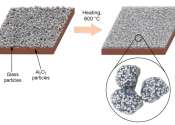Why fashion's 'recycling' is not saving the planet
In H&M's flagship Paris store it is hard to find clothes that don't claim to be made from "recycled materials".
Feb 7, 2024
0
1
Energy & Green Tech

In H&M's flagship Paris store it is hard to find clothes that don't claim to be made from "recycled materials".
Feb 7, 2024
0
1
Energy & Green Tech

The number of people living in urban areas around the world will swell by upwards of 2 billion over the next three decades. Many of those people will need new homes. But building those with conventional materials would unleash ...
Jan 25, 2024
0
4
Automotive

U.S. consumers looking to get a tax credit on an electric vehicle purchase have fewer models to choose from under new rules that limit the countries where automakers can buy battery parts and minerals—a potential blow to ...
Jan 10, 2024
0
13
Business

With several billion dollars available from the Inflation Reduction Act for upgrades to increase energy efficiency of the home, now is the time for consumers to take advantage of federal government subsidies that will help ...
Dec 29, 2023
0
68
Energy & Green Tech

LED lighting is up to 44% more efficient than 4-foot fluorescent tubes, according to a University of Michigan study.
Dec 6, 2023
0
10
Consumer & Gadgets

So you program your thermostat to save heating costs, recycle glass and plastic, ride a bicycle to work instead of driving a car, reuse sustainable grocery bags, buy solar panels, and shower with your mate—all to do your ...
Engineering

University of Maryland researchers aiming to combat rising global temperatures have developed a new "cooling glass" that can turn down the heat indoors without electricity by drawing on the cold depths of space.
Nov 13, 2023
0
128
Engineering

Scientists at the University of Bristol have successfully used screws as connectors in bamboo without splitting the material.
Oct 9, 2023
0
72
Energy & Green Tech

President Emmanuel Macron said on Monday France will triple its heat pump production over the next four years as part of a government climate plan.
Sep 25, 2023
0
3
Engineering

In October this year the new Sustainable Buildings State Environmental Planning Policy will require architects and developers in NSW to start measuring the embodied carbon in their designs as Australia seeks to transition ...
Sep 1, 2023
0
20
A carbon footprint is "the total set of GHG (greenhouse gas) emissions caused directly and indirectly by an individual, organization, event or product" (UK Carbon Trust 2008). An individual, nation, or organization's carbon footprint is measured by undertaking a GHG emissions assessment. Once the size of a carbon footprint is known, a strategy can be devised to reduce it.
Carbon offsets, or the mitigation of carbon emissions through the development of alternative projects such as solar or wind energy or reforestation, represent one way of managing a carbon footprint.
The concept and name of the carbon footprint originates from the ecological footprint discussion. The carbon footprint is a subset of the ecological footprint.
This text uses material from Wikipedia, licensed under CC BY-SA